INTRODUCTION
Acute gastroenteritis is an important public health issue worldwide [Reference Kosek, Bern and Guerrant1–Reference Guerrant4]. In developed countries, while mortality is low, the associated morbidity remains high [Reference Helms5–Reference Thapar and Sanderson8]. In order to better estimate the true level of morbidity in the community, several countries have conducted population-based studies [Reference Monto and Koopman9–Reference Gauci22]. Using prospective and retrospective methodologies, these studies have collected self-reported information from random samples of their target populations, including information on gastrointestinal symptoms (vomiting and diarrhoea) and their severity, secondary symptoms, pre-existing conditions, health-care use and burden, possible causes, and demographics. In these studies, gastroenteritis refers to the acute onset of enteric symptoms unrelated to existing health conditions, medication use, or other non-infectious causes, and is defined by its clinical picture, with symptom-based case definitions used to classify individuals as cases or non-cases. These case definitions are designed and used to estimate total morbidity, not as part of ongoing public health surveillance of enteric disease.
Comparing the results of such studies is complicated because both the terms used for the illness and the symptom-based case definitions vary, despite the fact that the studies are essentially evaluating the same phenomenon. This problem, although widely noted in the literature [Reference Kosek, Bern and Guerrant1, Reference Wheeler10, Reference Hoogenboom-Verdegaal12, Reference Majowicz15, Reference Kuusi16, Reference Scallan19, Reference de Wit20–Reference Gauci22] has only been explored in a preliminary fashion using data from one country [Reference Majowicz23, Reference Majowicz and Stacey24]. Ultimately, a common, validated case definition and common set of reported results are needed to ensure comparability across population-based studies of gastroenteritis and to provide a credible estimate of the global burden of disease.
The current lack of a standard definition is due, in part, to the subjectivity of gastroenteritis as a syndrome. Additionally, it stems from the need for individual studies to be able to tailor their case definition to their specific purposes (e.g. diarrhoeal disease vs. acute gastrointestinal illness), to make their case definition and thus their data consistent with other previously collected data within their country, and to work within existing administrative, research, or other frameworks. Most studies already collect data in a manner which would allow more than one symptom-based case definition to be applied post hoc, although not all studies have collected all specific data items which could be important. Future studies could easily adapt data collection to enable the application of any study-specific case definitions, as well as a commonly agreed standard definition for international comparison purposes.
The objectives of our investigation were to:
(a) demonstrate the impact of using different symptom-based case definitions on the observed epidemiology of gastroenteritis;
(b) assess the feasibility of developing ‘case definition multipliers’ for use in adjusting for variation in incidence rates among studies; and
(c) recommend a standard, symptom-based case definition for gastroenteritis, along with a minimum set of results to be reported under this definition, to facilitate countries in collecting information necessary to allow accurate inter-country comparisons.
METHODS
This analysis was conducted using population-based survey data on gastroenteritis from Australia, Canada, Ireland, Malta, and the United States. The original study methodologies are described in Table 1. In these studies, gastroenteritis refers to the acute onset of enteric symptoms unrelated to existing health conditions, medication use, or other known non-infectious causes. The population covered in the five study areas ranged from 44 million in the United States to 0·38 million in Malta, and the sample sizes varied from 16 435 (United States) to 3496 (Canada).
Table 1. Original methodologies of the five population-based studies of gastroenteritis whose data were used in this analysis
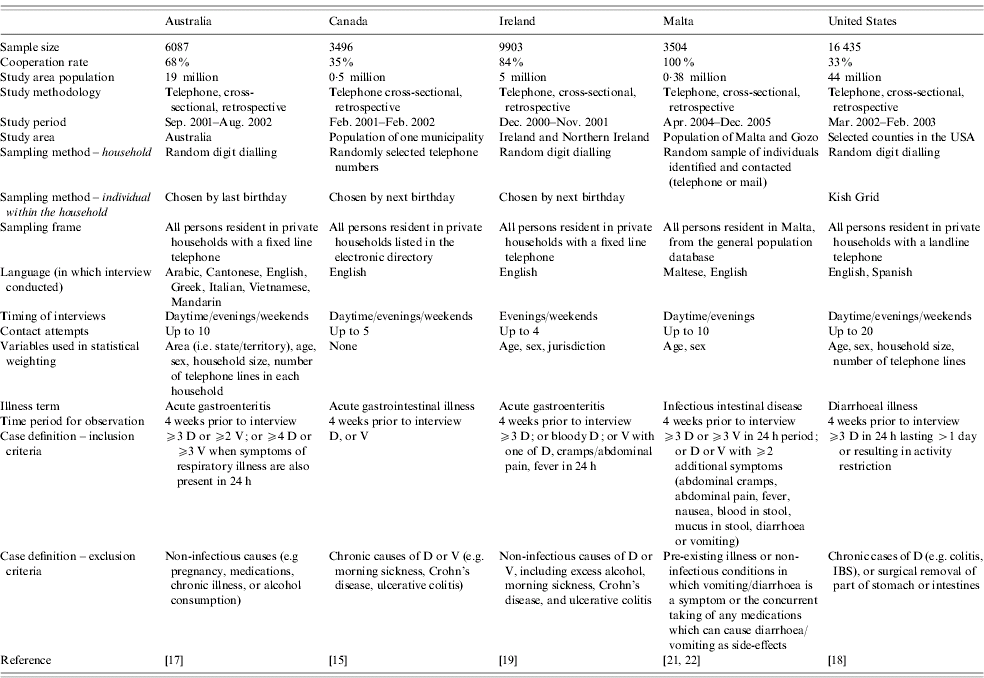
D, Diarrhoea (i.e. loose stool); V, vomiting IBS, irritable bowel syndrome.
Four symptom-based case definitions (FoodNet [Reference Herikstad14], Irish [Reference Scallan19], National Studies of Acute Gastrointestinal Illness (NSAGI) [Reference Majowicz15], and Norwegian [Reference Kuusi16]) were selected from the literature to reflect the range of published definitions from community-based studies of gastroenteritis that could be applied to existing population data from the five countries (Table 2). These definitions were applied to individual country data by investigators within that country. For this analyses, all individuals not meeting the case definition were included in the non-case group.
Table 2. Published symptom-based case definitions for gastroenteritis applied in this analysis to population data from Australia, Canada, Ireland, Malta, and the United States
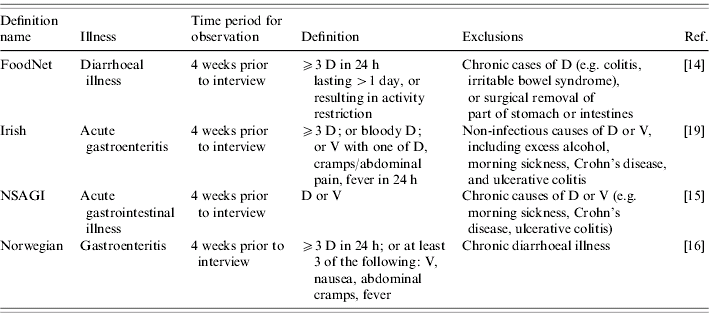
FoodNet, United States Foodborne Diseases Active Surveillance Network; NSAGI, National Studies on Acute Gastrointestinal Illness; D, diarrhoea (i.e. loose stool); V, vomiting.
We evaluated the impact of each case definition on observed estimates of incidence per person-year (overall and by gender), the mean age of cases, the proportion of cases with gastrointestinal symptoms (vomiting only, diarrhoea only, both vomiting and diarrhoea), the proportion of cases with secondary symptoms (bloody diarrhoea, fever), the mean duration of illness, and the proportions of cases who saw a physician, submitted a stool specimen, were hospitalized, missed work, and had ongoing symptoms at time of interview.
The results of these analyses were evaluated to determine if systematic differences in definitions existed that would enable the development of ‘case definition multipliers’. We hypothesized that if such systematic variation existed between case definitions (e.g. case definition A was two times greater than case definition B), multipliers could be used to relate the incidence estimates from studies which used different definitions.
The results of this investigation were used to develop a recommended standard case definition and recommended set of results to be reported. A draft standard definition, designed for simplicity and broad utility, was presented at the third Annual Meeting of the International Collaboration on Enteric Disease ‘Burden of Illness’ Studies (18 March, 2006, Atlanta, GA, USA). At that time, the Collaboration had representation from over 20 countries involved in conducting or planning burden-of-illness studies, of which population-based surveys of gastroenteritis form a main component [Reference Flint25]. The expert feedback obtained from this group informed the final standard case definition and minimum set of results to be reported. This definition was then applied to the data from the five countries participating in this analysis. Analyses were conducted in Microsoft Excel 2000 (Microsoft Corporation, Redmond, WA, USA), SPSS versions 12.0 and 14.0 for Windows (SPSS Inc., Chicago, IL, USA), SAS version 9.1 (SAS Institute, Cary, NC, USA), and Intercooled Stata version 8 (Stata Corp, College Station, TX, USA).
RESULTS
The impact of using different case definitions
Under the four selected symptom-based case definitions (FoodNet, Irish, NSAGI, and Norwegian), the observed incidence per person-year for each of the five countries ranged as follows (Fig. 1): Australia [0·58 (95% CI 0·47–0·70) to 1·21 (95% CI 1·06–1·35)]; Canada [0·85 (95% CI 0·75–0·97) to 1·3 (95% CI 1·1–1·4)]; Ireland [0·43 (95% CI 0·38–0·63) to 0·75 (95% CI 0·69–0·81)]; Malta [0·21 (95% CI 0·19–1·90) to 0·37 (95% CI 0·35–1·89)] and the United States [0·59 (95% CI 0·55–0·64) to 1·03 (95% CI 0·97–1·09)]. Under the FoodNet definition, the incidence of gastroenteritis in Canada was significantly higher than in Australia, Ireland, and the United States, and the incidence in the United States was significantly higher than in Ireland. Under both the Irish and Norwegian definitions, the incidence of gastroenteritis in Australia, Canada, and the United States were not significantly different from each other, but were all significantly greater than the incidence in Ireland. Under the NSAGI definition, the incidence of gastroenteritis in Australia, Canada, and the United States were all significantly greater than the incidence in Ireland, and the incidence in Canada was significantly greater than the incidence in the United States. Under all definitions, the incidence of gastroenteritis in Malta was not significantly different than the incidence in any of the other countries.
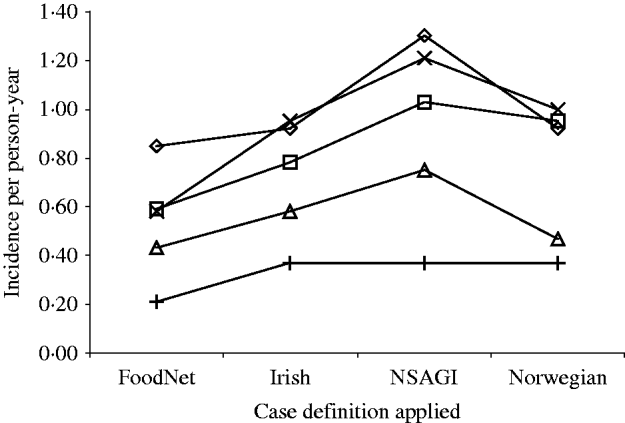
Fig. 1. Observed incidence per person-year, under the four selected symptom-based case definitions for gastroenteritis, in Australia (–×–), Canada (–◊–), Ireland (–△–), Malta (–+–), and the United States (–□–). NSAGI, National Studies of Acute Gastrointestinal Illness.
Although the use of different definitions impacted the incidence per person-year in males and females, the relative incidence varied little, with females consistently having a higher incidence than males under all definitions across all countries. Under the different definitions, the incidence in women was 1·3–1·4 times higher than the incidence in men in Australia, 1·2–1·4 times higher in Canada, 1·6–1·7 times higher in Ireland, 1·3–1·5 times higher in Malta, and 1·2–1·3 times higher in the United States. The mean age of cases observed varied under the four definitions, although the difference was always <5 years.
The proportion of cases with bloody diarrhoea is shown in Figure 2. The observed proportion of cases with bloody diarrhoea was highest under the FoodNet definition for Australia, Malta, and the United States, under the Irish definition for Canada, and under the Norwegian definition for Ireland. The observed proportion of cases with fever varied by definition and country, and was highest under the Irish definition (Australia and the United States), the Norwegian definition (Canada and Ireland), and the FoodNet definition (Malta).
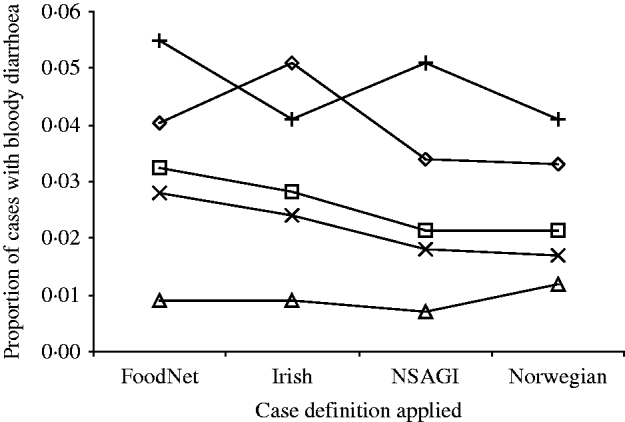
Fig. 2. Observed proportion of cases with bloody diarrhoea, under the four selected symptom-based case definitions for gastroenteritis, in Australia (–×–), Canada (–◊–), Ireland (–△–), Malta (–+–), and the United States (–□–). NSAGI, National Studies of Acute Gastrointestinal Illness.
The proportion of cases who visited a physician for their illness varied by case definition (Fig. 3), with the highest proportion of cases seeking medical care observed under the FoodNet definition (Australia, Canada, and Malta), and equally high under the Irish and Norwegian definitions (Ireland and the United States). The proportion visiting a physician in Australia, Canada, and the United States were similar under the Irish, NSAGI, and Norwegian definitions. The proportion of cases who submitted a stool sample (Fig. 4) was highest under the FoodNet definition (Australia, Canada, and Ireland), the Irish definition (United States), and equally high under the Irish, NSAGI and Norwegian definitions (Malta). Except in Malta, this proportion was consistently lowest under the NSAGI definition for all countries.
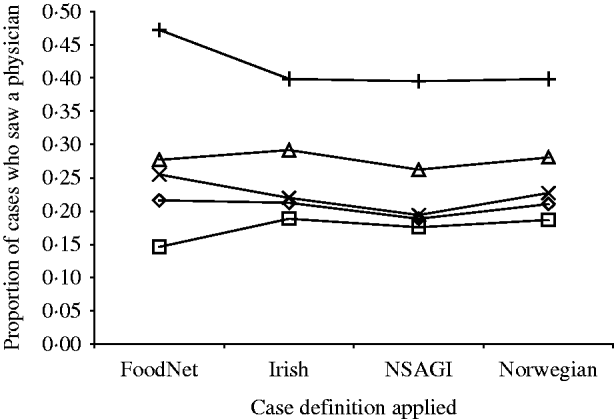
Fig. 3. Observed proportion of cases who saw a physician for their illness, under the four selected symptom-based case definitions for gastroenteritis, in Australia (–×–), Canada (–◊–), Ireland (–△–), Malta (–+–), and the United States (–□–). NSAGI, National Studies of Acute Gastrointestinal Illness.
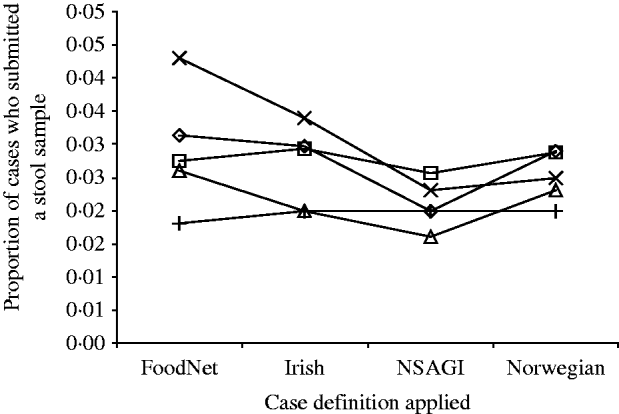
Fig. 4. Observed proportion of all cases who submitted a stool specimen, under the four selected symptom-based case definitions for gastroenteritis, in Australia (–×–), Canada (–◊–), Ireland (–△–), Malta (–+–), and the United States (–□–). NSAGI, National Studies of Acute Gastrointestinal Illness.
The mean duration of illness varied by about half a day, and ranged from 2·4 to 3·2 days (Australia), 4·2–4·8 days (Canada), 4·2–4·3 days (Malta), and 3·3–3·6 days (United States). However, the mean duration of illness was 2 days in Ireland under all of the four different definitions. The observed proportion of cases whose symptoms were still ongoing at the time of interview ranged just under 2% in Malta (18·2–20·0%) and the United States (10·8–11·0%), to just over 3% in Australia (5·4–8·7%), Canada (14·0–17·9%), and Ireland (17·3–20·7%).
Feasibility of case definition multipliers
The incidence of gastroenteritis was always the lowest under the FoodNet definition, regardless of country. In Malta, the incidence under each of the other three definitions was 1·8 times greater than the incidence under the FoodNet definition. In the other four countries, the incidence of gastroenteritis was highest under the NSAGI definition, and was 1·5 (Canada), 1·7 (Ireland, United States), and 2·1 (Australia) times higher than the incidence observed under the FoodNet definition. Under the Irish and Norwegian definitions the patterns were less clear. In Canada, the incidence under these two definitions was 1·1 times greater than the incidence under the FoodNet definition. The ratio to the FoodNet definition was greater for the Norwegian definition vs. the Irish definition in Australia (1·7 vs. 1·6) and the United States (1·6 vs. 1·3). However, the ratio to the FoodNet definition was less for the Norwegian definition vs. the Irish definition in Ireland (1·1 vs. 1·3).
Recommended standard case definition and minimum set of results
The following standard symptom-based case definition for gastroenteritis was chosen: a case of gastroenteritis is an individual with ⩾3 loose stools, or any vomiting, in 24 h, but excluding those (a) with cancer of the bowel, irritable bowel syndrome, Crohn's disease, ulcerative colitis, cystic fibriosis, coeliac disease, or another chronic illness with symptoms of diarrhoea or vomiting, or (b) who report their symptoms were due to drugs, alcohol, or pregnancy. This case definition can be used with any time period for observation (e.g. in the 4 weeks prior to the interview). This definition was chosen for its simplicity, acceptability and mid-range severity of symptoms: these elements are particularly important when considering the range of countries that have an interest in the burden of gastroenteritis, including both developed and developing countries.
Applying the standard definition to data from Australia, Canada, Ireland, Malta, and the United States (Table 3) illustrated that the incidence of gastroenteritis was highest in Australia, Canada, and the United States (where the incidences were not significantly different), followed by Ireland. Although Malta had the lowest incidence, it was not significantly different than the incidence in any of the other countries.
Table 3. Epidemiology of gastroenteritis under the standard case definition (⩾3 loose stools, or any vomiting, in 24 h, excludingFootnote * those (a) with cancer of the bowel, irritable bowel syndrome, Crohn's disease, ulcerative colitis, cystic fibriosis, coeliac disease, or another chronic illness with symptoms of diarrhoea or vomiting, or (b) who report their symptoms were due to drugs, alcohol, or pregnancy) in Australia, Canada, Ireland, Malta, and the United States
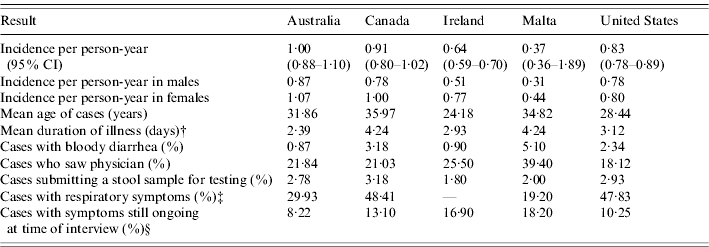
* Individuals meeting the exclusion criteria were retained in the non-case group.
† Mean duration calculated by averaging the duration of illness for all cases, regardless of whether they were still ongoing at the time of data collection.
‡ Coughing, sneezing, sore throat, runny nose.
§ For retrospective studies.
DISCUSSION
Using different symptom-based case definitions for gastroenteritis impacts the observed epidemiology of disease in a given population. The four different case definitions applied produced different incidence estimates within a given country, suggesting that the direct comparison of such estimates between studies with different case definitions may not be valid. Additionally, the comparison of results that rely on estimates of incidence or the number of cases, for example burden and cost estimates, may not be valid unless it accounts for variation due to case definition. This is important, not only when comparing results between studies, but also when generating global burden-of-disease estimates.
Unfortunately, this analysis did not include data or evaluate case definitions from studies conducted in developing countries, as such information was unavailable at the time. Thus, the repetition of this analysis in future using information from developing countries is merited. Moreover, given that the epidemiology of gastroenteritis probably differs between developing and developed countries, future analyses should evaluate how different case definitions (including the standard definition presented here) impact the observed incidence and distribution of gastroenteritis in developing countries in relation to developed countries.
An objective of this study was to assess the feasibility of developing case definition multipliers which could be used to adjust for variation between incidence rates generated under different definitions. We considered the results from five countries too limited to generate specific multipliers between all four definitions, but they do suggest that liberal definitions, like the NSAGI definition (loose stool or vomiting) generate incidence estimates about 1·5–2 times greater than incidence estimates generated by stricter definitions, such as the FoodNet definition (⩾3 loose stools in 24 h, lasting >1 day or resulting in activity restriction). Further assessment is needed, ideally involving data from all countries that have conducted population-based studies of gastroenteritis, to definitively determine whether universal multipliers exist between specific definitions. The validity of specific country estimates should also be subjected to evaluation against methodologies such as serological surveys.
Interestingly, although the use of different definitions produced different gender-specific incidence values and age distributions, the overall conclusions were not impacted significantly since higher rates in women than men were always observed, and the mean age of cases varied by <5 years. However, it should be noted that eventual inclusion of studies from developing countries may result in wider variation.
The choice of symptom-based case definition impacted the observed clinical picture of illness. As expected, stricter definitions tended to generate higher observed proportions of cases with bloody diarrhoea or fever, although the overall magnitude of the change under the different definitions was small. However, if such data are used to determine symptom-specific burden-of-illness estimates, such as the burden and cost due to bloody diarrhoea, the potential for such estimates to be affected by the chosen case definition should be stated. The observed duration of illness varied under the different definitions, albeit by <1 day. However, this level of variation is still important since variation of 1 day against a mean duration of 4 days will impact burden estimates by 20%. Thus, as above, comparisons of durations between studies, or of results that rely on duration-of-illness estimates, should acknowledge the potential that such estimates are affected by the case definition chosen. Lastly, the proportion of cases seeking medical care and submitting stool samples for testing was impacted by the choice of case definition, suggesting that under-reporting estimates derived from these values may not be directly comparable across studies using different case definitions.
In light of the results of this study, we recommend the following standard, symptom-based case definition: a case of gastroenteritis is defined as an individual with ⩾3 loose stools, or any vomiting, in 24 h, but excluding those (a) with cancer of the bowel, irritable bowel syndrome, Crohn's disease, ulcerative colitis, cystic fibriosis, coeliac disease, or another chronic illness with symptoms of diarrhoea or vomiting, or (b) who report their symptoms were due to drugs, alcohol, or pregnancy. Furthermore, we recommend that the results given in Table 3 be a minimum set of reported results, to facilitate accurate inter-country comparisons and global burden-of-disease estimates. We recognize that the definition is based, in part, on pragmatism, in that it was not chosen solely to improve the accuracy of case classification but also for its simplicity and broad applicability. However, the benefit gained by the removal of the variation due to case definition when comparing results between studies justifies its adoption and use, and we advocate that future population-based studies of gastroenteritis structure data collection so that this standard definition can be applied and the minimum set of results under this definition be reported.
The recommended standard case definition can be used with any time period for observation (e.g. the 4 weeks preceding the interview), however, the potential for recall bias to impact the results must be considered. Although recall bias is a recognized issue in retrospective surveys of gastroenteritis [Reference Wheeler10], there are no published studies which determine the most appropriate observation period to minimize recall bias in retrospective studies of gastroenteritis. To date, the majority of retrospective studies use an observation period of the 4 weeks preceding the interview [Reference Herikstad14–Reference Scallan19, Reference Gauci21, Reference Gauci22], and future studies may choose to use this same period to maintain consistency. However, determining which observation period minimizes recall bias is a critical methodological issue that should be addressed in future.
In and of themselves, the minimum sets of results reported here for the five countries should not be used directly. Rather, the results reported in the original studies should be taken as the estimates of the epidemiology of gastrointestinal illness in the study populations [Reference Majowicz15, Reference Hall17–Reference Scallan19, Reference Gauci21, Reference Gauci22]. These standardized values, which provide a more accurate way of comparing results between studies, should be used to compare the epidemiology of gastroenteritis between Australia, Canada, Ireland, Malta, and the United States.
It is important to note that, while having a standard case definition improves the comparability of results between population-based studies of gastroenteritis, other methodological issues potentially affecting comparability exist, which should be addressed in future. For example, several studies have evaluated aspects of the relationship between respiratory symptoms and gastrointestinal symptoms in cases of gastroenteritis [Reference Mead6, Reference Monto and Koopman9, Reference Hall17], under the rationale that when studies aim to estimate gastroenteritis, researchers should attempt to exclude those whose gastrointestinal symptoms are due to respiratory infection. Since these studies do not provide conclusive guidance on such exclusion criteria, no attempt was made here to exclude cases on the basis of respiratory symptoms. However, as reflected in the minimum set of results to be reported, we suggest that population-based studies of gastroenteritis should collect information on whether cases also experienced respiratory symptoms (sore throat, runny nose, coughing, sneezing) and report this proportion, so that as the appropriate exclusion criteria are developed, individuals can be excluded accordingly.
Aside from case definition considerations, other methodological issues which may impact comparability between studies pertain to study design and data analysis. Study design considerations include determining the most appropriate time period for observation in retrospective studies, evaluating how the results from retrospective and prospective studies relate, and defining an appropriate symptom-free period prior to illness. Analytical considerations include appropriate methods for calculating duration of illness in retrospective studies. Difficulties arise when calculating the mean duration for two reasons. For those who are still suffering symptoms, the reported duration will underestimate the total duration of illness because the episode of illness is not yet complete; this is usually addressed using survival analysis, as some of the data are censored. However, individuals with longer durations of illness are more likely to be included as cases in retrospective surveys than individuals with shorter durations; this bias arises from the same process that gives rise to length bias in screening programmes, and its impact has not yet been evaluated. Further exploration of these various factors is needed.
CONCLUSIONS
In a given country, using different symptom-based case definitions for gastroenteritis affects its observed epidemiology, with different definitions yielding different estimates of the incidence, as well as moderately different clinical pictures of disease. To facilitate accurate inter-country comparisons of population-based studies of gastroenteritis, diarrhoeal disease, and enteric disease, we recommend a common symptom-based case definition, as well as a minimum set of results to be reported under this definition. We advocate that this definition and its set of results be reported alongside any other study-specific definitions in future population-based studies, that this analysis be repeated with data from developing countries, and that countries with existing population-based data apply this definition in a re-analysis of their results. Removing the variation due to differences in case definition will also contribute to developing credible estimates of the global burden of gastroenteritis.
ACKNOWLEDGEMENTS
The authors thank the ‘International Collaboration on Enteric Disease Burden of Illness Studies’ for providing feedback on the overall concept, and for reviewing drafts of the standard definition; in particular, the authors thank Frederick Angulo and Martyn Kirk.
DECLARATION OF INTEREST
None.









